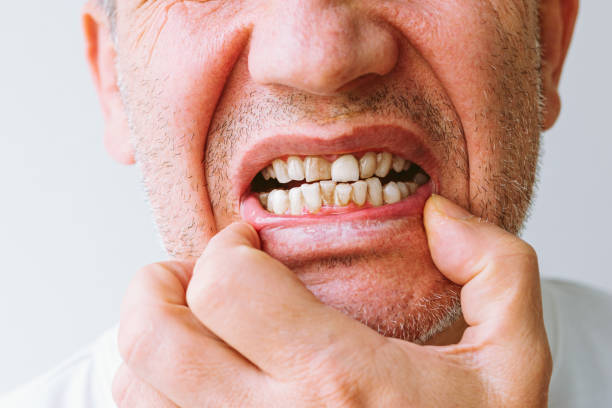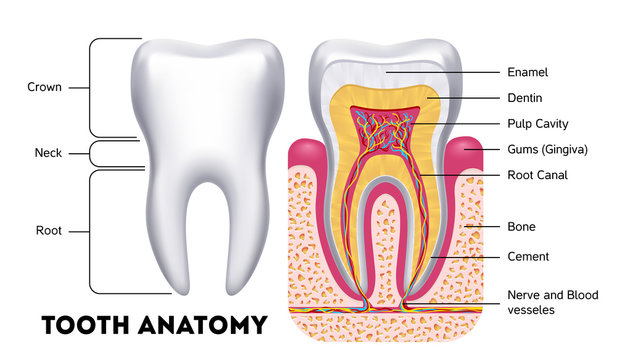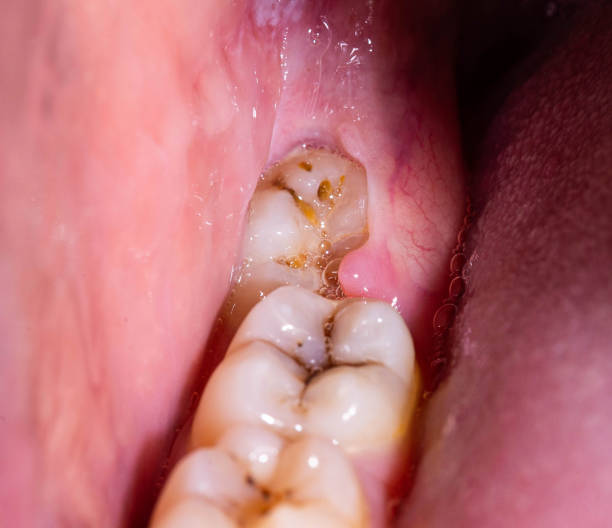Cavity on Front Tooth: Causes, Symptoms, Treatment, Filling & More.

A beautiful smile can make a lasting impression, but what happens when a cavity appears on our front tooth?
Cavities, also known as dental caries, are common oral health issues that can affect any tooth, including those that are visible when we smile.
When cavities come to mind, the typical image is often that of back molars, worn down by years of indulging in crunchy snacks and sweets. Brushing or flossing those back teeth can indeed be a bit of a challenge.
But here’s something important to know: our front teeth, which are smoother and easier to clean, aren’t exempt from cavities. Yep, even those pearly whites you proudly show off when you smile can develop decay if we don’t take care of them.
While cavities on front teeth are less common than those on molars, they can still occur and cause discomfort, aesthetic concerns, and potential complications.
Read Also: Symptoms of Wisdom Tooth Infection.
Table of Contents
Anatomy of the Front Tooth

To understand how cavities form in the front teeth, let’s see in a quick easy picture how the front teeth are built.
Front teeth are like the superheroes of your mouth! They have an important role in keeping your smile bright and healthy. Let’s take a closer look at their structure and how they contribute to your oral health.
Did you know that front teeth have layers? It’s like they’re wearing protective armour! The outermost layer is called enamel. It’s strong and shiny, just like a knight’s shield.
Underneath the enamel, there’s dentin, which is a bit softer and yellowish. Think of it as the tooth’s trusty sidekick. And deep inside, we have the pulp, which houses all the nerves and blood vessels, like the heart of our toothy hero!
Uh-oh! Front teeth can be vulnerable to those pesky cavities. Cavity on front tooth is caused by tiny bacteria that love to feast on sugary treats. They produce acids that can wear down the enamel, making it easier for cavities to form.
Other factors cause cavities in the front teeth, like poor oral hygiene, not-so-healthy diets, and even genetics. So, remember to brush those front teeth like a pro and keep those sugary villains at bay!
Related: Dental Caries: Symptoms, Treatment and Prevention.
How do Cavities Form on the Front Tooth?

The Sticky Culprit: Dental Plaque and its Role in Cavity on front tooth formation
Picture this: Your front teeth have an invisible enemy called dental plaque. It’s like a clingy film that forms on your teeth after eating or drinking.
Plaque is a sneaky troublemaker as it harbours harmful bacteria that love to party on your pearly whites. And guess what? These bacteria produce acids that can lead to cavity on front tooth formation.
Demineralization
Let’s do some tooth science, shall we? Demineralization is like a slow attack on your front teeth. The acids from plaque erode the minerals from the enamel, making it weak and prone to cavities.
The Bacteria Brigade and front tooth cavity formation
Here come the bacteria! These microscopic troublemakers are the main culprits behind cavity formation. They thrive on sugars from your snacks and drinks, producing acids that wreak havoc on your front teeth.
They’re like tiny wrecking balls, breaking down the protective layers of your teeth and paving the way for cavities to take hold. But fear not, you can fight back!
The secret weapon – oral hygiene! Brushing your front teeth twice a day and flossing like a dental ninja can make a huge difference.
By removing plaque and bacteria, you’re giving your front teeth a fighting chance against cavities. And don’t forget those superhero visits to your friendly dentist! They can spot a cavity on front tooth early and provide the necessary treatments to save your smile.
What Causes a Cavity on front tooth?
Cavity on front tooth don’t appear out of thin air! Several factors team up to create the ideal environment for those pesky cavities to form. Let’s uncover the main culprits behind these dental villains.
Diet and sugary foods/drinks.Sweet Treats and Sneaky Sips
Watch out for the sugar invaders! Diets high in sugary foods and drinks can be a major contributor to front tooth cavities.
Those tasty treats provide fuel for harmful bacteria in your mouth, leading to the production of cavity-causing acids. So, remember to enjoy sugary goodies in moderation and be mindful of those sneaky sips of sugary beverages.
Poor oral hygiene practices
Attention, oral hygiene warriors! Poor oral hygiene practices can spell trouble for your front teeth. Skipping brushing sessions or not giving it the attention it deserves allows dental plaque to accumulate. This sticky film becomes a breeding ground for bacteria and their acid attacks. So, when brushing, be thorough!
Genetics
Your DNA can play a role in your susceptibility to cavities, including those on your front teeth. Some people may have inherited a higher risk of tooth decay. But fear not, with diligent oral care, you can still keep those cavities at bay and maintain a healthy smile.
Effect of dry mouth and reduced saliva production
When your mouth turns into a desert, trouble can follow. A dry mouth, caused by reduced saliva production, creates an environment where bacteria and acids can run wild. Saliva is like a superhero that helps wash away food particles and neutralize acids.
So, stay hydrated, chew sugar-free gum, or talk to your dentist about remedies for dry mouth to keep your front teeth happy and cavity-free.
Dental plaque and its role in cavity formation
As discussed earlier! This sticky film loves to cling to your front teeth, housing harmful bacteria that feast on sugars and produce cavity-causing acids.
If plaque isn’t regularly removed through brushing and flossing, it can lead to enamel erosion and teeth cavities. Stay vigilant and keep that plaque in check!
Acidic foods and beverages that can erode tooth enamel
Beware the acid attackers! Consuming highly acidic foods and beverages can erode the protective enamel of your front teeth, making them more susceptible to cavities. So, while you enjoy your citrusy treats or acidic drinks, remember to rinse your mouth with water afterwards to minimize the acid’s harmful effects.
Genetics
Sometimes, genetics can be a wild card. You might have inherited certain traits that make your front teeth more prone to cavities. But don’t worry! With a proactive approach to oral care, you can still maintain a healthy smile regardless of your genetic predisposition.
Age
As time marches on, so does the impact on our teeth. Age can contribute to cavity formation on front teeth. Over the years, wear and tear, along with changes in saliva production and oral health habits, can increase the risk of cavities. It’s never too late to prioritize your dental care, no matter your age.
Detecting Cavity on front tooth: Signs and Symptoms to Watch For
Early warning signs and subtle indications of front tooth cavities
Front tooth cavities may start with gentle whispers rather than loud alarms. Pay attention to these early warning signs that something might be amiss.
You might experience occasional tooth sensitivity or a fleeting twinge of discomfort. These subtle indications can be gentle nudges to seek dental care and nip the cavities in the bud.
The visual appearance of Cavity on front tooth
Take a closer look in the mirror! Cavities on front teeth might reveal themselves as visible spots or discolourations. They can appear as dark or white spots on the enamel, indicating the presence of decay. Keep an eye out for these visual clues and let your dentist know if you spot anything unusual.
Sensitivity to hot, cold, or sweet stimuli
Hot, cold, or sweet, oh my! Front tooth cavities can make you wince when exposed to temperature extremes or sugary treats.
If you feel a zing of discomfort or lingering sensitivity when enjoying your favourite hot coffee or biting into an ice cream cone, it could be a sign that cavities are lurking. Don’t ignore these sensations and let your dentist investigate further.
Colour and Texture Ch-Ch-Changes
Your front teeth may start to show some artistic changes if cavities are present. Keep an eye out for alterations in colour or texture. Cavities can cause discolouration, ranging from light brown to black spots.
Additionally, you might notice rough or pitted areas on the surface of your front teeth. If your teeth no longer feel smooth and pristine, it’s time to get them checked out.
Pain or discomfort in the front tooth
When cavities progress, they can bring along their unwelcome friend—pain. If you experience sharp or persistent toothaches, especially in your front teeth, it’s time to schedule a dental visit.
Cavity on front tooth that reach the inner layers of the tooth can irritate nerves, causing discomfort. Your dentist can diagnose the cause of your pain and provide the necessary treatment.
If front tooth cavities are left untreated, they can lead to complications. The decay can spread, reaching deeper layers of the tooth, potentially causing infections or abscesses.
Ignoring cavities can result in more extensive and costly dental procedures down the road, such as root canals or even tooth loss. So, don’t let a small cavity turn into a big problem—seek timely treatment to protect your oral health.
Identifying, Diagnosing and Treating the Cavity on the Front Tooth?
Regular Dental Check-ups and X-rays: Your Allies in Early Detection
Don’t underestimate the power of regular dental check-ups! Visiting your dentist every six months is key to identifying teeth cavities in their early stages.
During these check-ups, your dentist may also take X-rays, allowing them to detect cavities that may not be visible to the naked eye. By catching cavities early, you increase the chances of simpler and less invasive treatments.
Also Read: Operculectomy: Procedure and management.
Examining and Diagnosing a Cavity on front tooth
When you suspect a cavity in your front tooth, your dentist will perform a thorough examination. They will visually inspect your tooth, checking for discolouration, visible decay, or changes in texture.
They might also gently probe the tooth and use dental instruments to assess its integrity. Based on their findings, they can diagnose the cavity and determine the appropriate treatment.
Tailored Treatment Options for Cavity Severity
The treatment for your front tooth cavity will depend on its severity. If caught early, a simple filling may suffice.
Your dentist will remove the decayed portion of the tooth and fill the space with a tooth-coloured material, restoring both function and appearance. In more advanced cases, a root canal procedure might be necessary to address decay that has reached the tooth’s inner pulp.
Your dentist will discuss the options and recommend the most suitable treatment for your specific situation.
Say Goodbye to Decay: Tooth Decay Removal Procedures
To remove the decayed portion of your front tooth, your dentist may employ various techniques. Traditional drilling using dental drills is a common method. It sounds scarier than it is! Local anaesthesia is used to ensure your comfort throughout the procedure.
Another alternative gaining popularity is laser therapy, where focused light energy is used to remove decayed tissue. Your dentist will choose the approach that best fits your case, ensuring the decay is thoroughly removed before proceeding with the restoration.
Potential Complications and Risks During Cavity Treatment
While cavity treatments are generally safe, it’s essential to be aware of potential complications. These can include temporary sensitivity after the procedure, allergic reactions to materials used, or the possibility of the cavity recurring if oral hygiene is not maintained.
Your dentist will explain any risks associated with the specific treatment option and address any concerns you may have.
How to Prevent Cavity on Front Tooth?
Prevention is the name of the game when it comes to keeping cavities away from your front tooth. It keeps teeth and gums healthy and reduces the risk of cavities and gum disease. Below are ways to prevent cavity on front tooth;
Maintain Good Daily Oral Hygiene Habits
Brushing and flossing are your dynamic duo in the fight against cavities. Brush your front teeth at least twice a day, using a soft-bristled toothbrush and fluoride toothpaste.
Pay attention to every nook and cranny, spending around two minutes each time. And don’t forget about flossing!
This removes plaques and food particles from between your teeth. Make it a daily habit for a sparkling smile!
Use fluoride toothpaste and mouthwash for Cavity on front tooth prevention
Say hello to fluoride, the cavity-fighting superstar! Use fluoride toothpaste when brushing your front teeth. Fluoride strengthens your tooth enamel, making it more resistant to decay.
For an extra boost, use fluoride mouthwash as part of your oral hygiene routine. It’s like a shield that helps protect your front teeth from those cavity-causing villains.
Limit sugary and acidic foods/drinks Intake
Watch out for sugar and acid—they can be the archenemies of your front teeth.
Limit your consumption of sugary foods and drinks, especially those sticky, sugary snacks that love to cling to your teeth.
Also, be mindful of acidic foods and beverages, as they can weaken your tooth enamel. Opt for healthier alternatives and rinse your mouth with water after indulging in sugary or acidic treats. Your front teeth will thank you!
The Role of dental sealants and fluoride treatments
For an added layer of protection, consider dental sealants and fluoride treatments. Dental sealants are thin coatings applied to the chewing surfaces of your teeth, including the front ones.
They act as a barrier, preventing plaque and bacteria from settling in the grooves and crevices of your teeth. Fluoride treatments, often applied during dental visits, further strengthen your tooth enamel.
Talk to your dentist about these preventive options to keep those front teeth strong and cavity-resistant.
Regular dental check-ups and professional cleanings
Don’t forget to assemble your dental team of superheroes! Schedule regular dental check-ups and professional cleanings every six months.
Your dentist will examine your front teeth, identify any early signs of cavities, and provide professional cleanings to remove stubborn plaque and tartar.
These visits are necessary for maintaining optimal oral health and catching any issues before they become major problems.
Treating Cavity on front tooth

When it comes to treating cavities on front teeth, different treatment options are available based on the severity of the cavity. Here’s an overview of the main options:
Non-invasive Approaches for Early-Stage Cavities
Fluoride Treatment and Remineralization
Fluoride treatment and remineralisation are important for maintaining oral health and preventing tooth decay.
Fluoride helps strengthen tooth enamel, making it more resistant to acid attacks from bacteria and sugary foods. It replenishes essential minerals, such as calcium and phosphate, promoting remineralization and repairing early-stage cavities.
This process helps restore the strength and integrity of the enamel, reducing the risk of further decay.
Fluoride treatment is applied during a dental visit, providing a simple and effective way to enhance the health and strength of your teeth.
Advantages:
- Strengthens tooth enamel and can reverse early-stage decay.
- A non-invasive procedure, usually completed during a dental visit.
- Helps prevent further progression of cavities.
Disadvantages:
- Most effective for small, early-stage cavities.
- Requires regular application and maintenance for long-term effectiveness.
Dental Sealants for Preventive Care
Dental sealants are thin plastic coatings applied to the chewing surfaces of back teeth to protect against cavities. They create a barrier, preventing bacteria and food particles from causing decay. Sealants are easy to apply, painless, and provide long-lasting protection.
However, they only cover specific areas and may wear down over time, requiring occasional reapplication.
Advantages:
- Provides a protective barrier on the tooth surface, preventing cavity formation.
- Quick and painless application.
- Ideal for deep grooves and hard-to-reach areas on front teeth.
Disadvantages:
- Only applicable to cavity-free or minimally affected teeth.
- Regular monitoring and potential reapplication are required.
Fillings and Restorations for Moderate Cavities
Composite Fillings and Their Aesthetic Benefits
Composite fillings offer aesthetic benefits due to their natural tooth-coloured appearance. Unlike traditional silver amalgam fillings, composite fillings are made of a tooth-coloured resin material that can be matched to the shade of your natural teeth.
This allows the filling to blend seamlessly with the surrounding tooth structure, making it virtually indistinguishable.
Advantages:
- Natural tooth-coloured appearance, blending seamlessly with front teeth.
- Suitable for small to moderate cavities.
- Bonded directly to the tooth, requiring less removal of healthy tooth structure.
Disadvantages:
- More prone to wear and staining compared to other materials.
- May require replacement over time due to normal wear.
Amalgam Fillings as a Durable Option
Amalgam fillings are a durable choice for cavities. They are made of a mixture of metals and offer several advantages.
They are long-lasting, withstand chewing forces, and are cost-effective. However, they have a silver colour and require more tooth structure removal.
Advantages:
- Highly durable and long-lasting.
- Less expensive compared to composite fillings.
- Suitable for larger cavities or areas with high biting pressure.
Disadvantages:
- Less aesthetically pleasing due to their silver colour.
- Requires more removal of healthy tooth structure during preparation.
Root Canal Therapy for Advanced Front Tooth Cavities
When a cavity on front tooth becomes advanced, root canal therapy may be necessary to save the tooth. This procedure involves several steps to restore the tooth’s health.
Procedure and Steps Involved in Root Canal Therapy
- Examination and X-rays: The dentist will examine the tooth and take X-rays to assess the extent of the damage and determine if root canal therapy is needed.
- Anaesthesia: Local anaesthesia is administered to ensure a pain-free experience during the procedure.
- Accessing the pulp: The dentist creates a small opening in the tooth to access the infected pulp.
- Cleaning and disinfection: The infected pulp is carefully removed, and the canals are thoroughly cleaned and disinfected to eliminate bacteria.
- Filling and sealing: The canals are filled with a biocompatible material called gutta-percha and sealed to prevent reinfection.
- Restoration: After the root canal, a dental crown or filling is often placed to restore the tooth’s strength and appearance.
Advantages of Root Canal Therapy:
- Root canal therapy allows you to keep your natural tooth, avoiding the need for extraction and potential complications.
- The procedure eliminates the source of tooth pain and discomfort caused by infection.
- A restored tooth can function normally for biting, chewing, and speaking.
Disadvantages of Root Canal Therapy:
- Following the root canal, a dental crown or other restorative treatments may be necessary to strengthen the tooth further.
- In some cases, the treated tooth may become discoloured over time, requiring additional cosmetic treatments.
Dental Crowns and Veneers for Extensive Damage
In cases of extensive damage to front teeth, dental crowns and veneers can provide effective restoration.
Dental Crowns are tooth-shaped caps that cover the entire visible portion of a damaged tooth. They can be made from various materials, including porcelain, ceramic, or metal.
Dental Veneers are thin shells placed on the front surface of the teeth to improve their appearance.
Advantages of Dental Crowns:
- Crowns offer excellent strength and can withstand biting and chewing forces.
- They can be customized to match the colour, shape, and size of your natural teeth, enhancing your smile.
Disadvantages of Dental Crowns:
- To accommodate the crown, some healthy tooth structure needs to be removed.
Advantages of Dental Veneers:
- Veneers can transform the appearance of teeth by improving their colour, shape, and alignment.
- Compared to crowns, veneers require minimal removal of tooth structure.
Disadvantages of Dental Veneers:
- Once veneers are placed, they cannot be reversed.
Considerations for Selecting the Appropriate Restoration:
When choosing between crowns and veneers, factors such as the extent of damage, desired aesthetic outcome, and the dentist’s recommendation should be considered. Your dentist will assess your specific situation and help you decide which option is most suitable for restoring your smile.
When considering a suitable treatment approach for front tooth cavities, several factors should be taken into account:
- The severity of the cavity on front tooth: The extent of the cavity and the level of tooth damage will determine the appropriate treatment options.
- Aesthetic considerations: For front teeth, the appearance of the restoration is crucial. Options that offer natural-looking results should be considered.
- Tooth preservation: Whenever possible, preserving natural tooth structure is ideal to maintain oral health and function.
- Long-term prognosis: The longevity of different treatment options and their potential for future complications should be considered.
- Budget and insurance coverage: Financial considerations and insurance coverage may play a role in choosing the most suitable treatment option.
How and Ways to Cover a Cavity on Front Tooth
Let’s start with some cosmetic options that can help cover up those pesky front tooth cavities. We’ve got a few tricks up our sleeves!
One nifty way to treat your cavity is through dental bonding. It’s a conservative treatment option that involves applying a special resin to your tooth. It’s like giving your tooth a little makeover!
Another fantastic choice is porcelain veneers. These bad boys not only cover up cavities but also bring a bunch of benefits with them. They’re thin shells made of porcelain that are custom-made to fit your tooth perfectly. Talk about fancy!
If you’re looking for an aesthetic improvement, composite resin fillings are the way to go. These fillings are made of a tooth-coloured material that blends in seamlessly with your natural tooth. Say goodbye to those noticeable fillings!
Home Remedies for Cavities on Front Teeth
Let’s talk about some awesome home remedies to help with those cavities on your front teeth. Natural remedies can offer some relief for cavity on front tooth. They’re worth exploring! Here are a few ideas:
Oil pulling
It’s a technique where you swish oil (like coconut oil) around your mouth. Some people claim it has potential benefits for cavity treatment. Give it a try!
Simple rinsing with salt water or hydrogen peroxide solutions
They can reduce bacteria and provide a soothing effect. Just be sure not to swallow them!
Herbal remedies
Some herbs, like clove or tea tree oil, have properties that could be beneficial. Just make sure to do your research and consult with a healthcare professional.
Remember, these home remedies can complement your oral care routine, but they’re not substitutes for professional dental care. If you have a cavity, try to see a dentist for proper treatment. Take care of those pearly whites!
Filling Cavities on Front Teeth
When it comes to filling a Cavity on front tooth, the process is pretty straightforward. The dentist will first numb the area around the tooth to ensure you’re comfortable throughout the procedure. Then, they’ll remove the decayed part of the tooth using special dental tools.
Different filling materials can be used to repair the cavity. Two common options are amalgam and composite resin. Amalgam is a silver-coloured material that has been used for a long time, while the composite resin is tooth-coloured and blends naturally with your tooth.
The dental filling procedure involves a few steps. After removing the decayed part, the dentist will clean the area thoroughly. They’ll then apply the chosen filling material in layers, shaping and contouring it to match your tooth’s natural appearance. Once the filling is in place, it will be hardened using a special light. Finally, the dentist will polish the filling to make sure it feels smooth and comfortable.
Aftercare is important to ensure proper healing and minimize potential side effects. Your dentist will provide specific instructions, but generally, you’ll need to avoid chewing on hard or sticky foods for a little while. You might experience some sensitivity or discomfort, but it should subside gradually. If you notice any persistent issues or unusual symptoms, don’t hesitate to contact your dentist.
The Psychological Impact of Front Tooth Cavities
Front tooth cavities can greatly affect self-esteem and confidence. Having visible dental issues can make people feel self-conscious about their appearance, leading to a decline in self-esteem. It may make individuals hesitant to smile or engage in social interactions, impacting their overall confidence.
The social implications and challenges faced by individuals with front tooth cavities can be significant. They may experience embarrassment or judgment from others, which can lead to feelings of isolation. Engaging in activities such as eating, speaking, or even laughing in public may become a source of anxiety and discomfort.
Psychological support and coping strategies
Psychological support and coping strategies can play a crucial role in helping individuals navigate the psychological impact of front tooth cavities.
Seeking professional support from a dentist or therapist can provide a safe space to discuss concerns and explore potential treatment options.
Developing coping strategies, such as positive self-talk, focusing on inner strengths, and building a support network of understanding friends and family, can also be beneficial.
Conclusion: Cavity on Front Tooth

We covered a lot of ground in this article! We explored the causes and symptoms of cavities on front teeth, different treatment options, filling materials, home remedies, and the psychological impact. It’s important to be aware of these aspects to make informed decisions about your oral health.
Early detection and preventive measures are crucial when it comes to cavities. Regular dental check-ups can help catch cavities in their early stages, allowing for less invasive and more effective treatment. Brushing your teeth twice a day, flossing regularly, and maintaining a healthy diet low in sugary foods can go a long way in preventing cavities.
Remember, your oral health is important! Taking care of your teeth and gums not only helps prevent cavities but also contributes to your overall well-being. Prioritize your oral health by scheduling regular dental visits, practising good oral hygiene habits, and seeking professional help when needed.
FAQs: Cavity on front tooth
How long do fillings last on front teeth?
The lifespan of fillings on front teeth can vary depending on various factors, such as the type of filling material used, oral hygiene practices, and individual habits. Generally, composite resin fillings can last for several years, typically around 5 to 7 years. However, with proper care and regular dental check-ups, they can last even longer.
What does a cavity on the front teeth look like?
Cavities on front teeth can appear as small dark spots or discolouration on the affected tooth. They may also manifest as visible holes or pits on the tooth surface. However, cavities can sometimes be difficult to detect by visual inspection alone, so it’s important to visit a dentist for a thorough examination and diagnosis.
How do you get rid of a cavity in your front tooth?
To get rid of a cavity in your front tooth, professional dental treatment is necessary. The dentist will remove the decayed portion of the tooth using dental tools.
The next step involves filling the cavity with a suitable material, such as composite resin or another type of filling material, restoring the tooth’s shape and function.
The specific procedure may vary based on the extent of the cavity. It’s essential to consult with a dentist to determine the most appropriate treatment plan for your situation.



